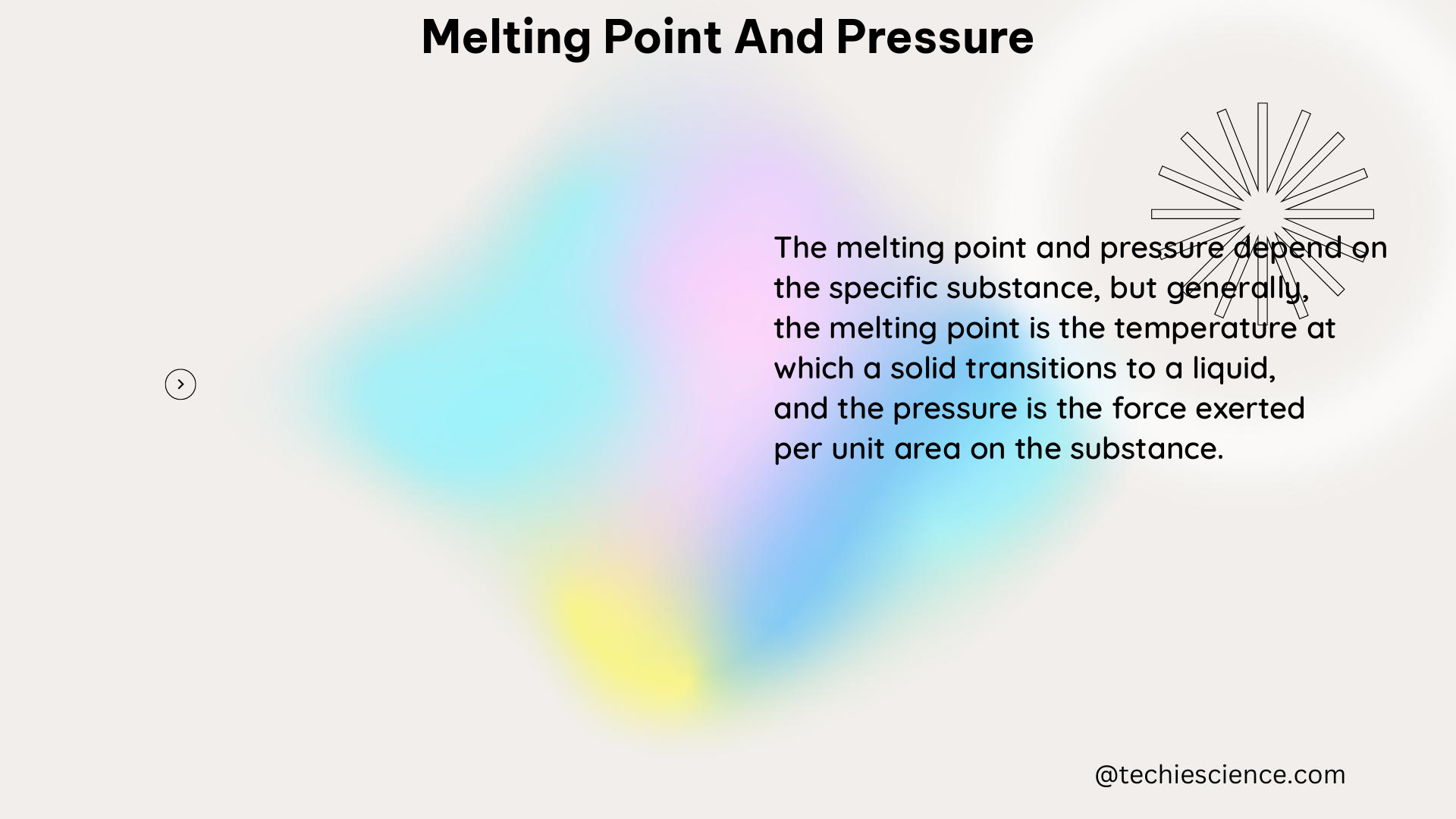The melting point and pressure of a substance are two closely interrelated physical properties that play a crucial role in understanding the behavior and characteristics of materials. This comprehensive guide delves into the intricate details of the melting point-pressure relationship, providing a wealth of information for physics students and researchers.
Understanding the Melting Point-Pressure Relationship
The melting point of a substance is the temperature at which the solid phase transitions into the liquid phase. However, this transition is not solely dependent on temperature; pressure also plays a significant role in determining the melting point of a substance.
According to the ScienceDirect Topics article, the melting pressure relation is non-linear and multi-valued, meaning that a single pressure can correspond to two different temperatures. This highlights the importance of knowing the precise pressure at which the melting point is measured, as it can significantly affect the temperature at which the substance melts.
Performing Melting Point Analysis

The Chemistry LibreTexts article provides a detailed explanation of the melting point analysis process, emphasizing the importance of controlling the pressure during the analysis. The article states that the melting point is dependent on pressure, and experimental results can vary from literature values, especially in extreme locations, such as high-altitude environments.
The Westlab Canada article further emphasizes the importance of accurate and precise melting point determination, as it can provide valuable information about the purity and identity of a substance. Impurities and other factors, such as pressure and humidity, can affect the melting point of a substance, underscoring the need to control these variables during the analysis.
Quantifiable Data and Relationships
The ScienceDirect Topics article presents a graph showing the melting pressure relation for various substances, which can be used to determine the pressure at which a substance will melt at a given temperature. Additionally, the Chemistry LibreTexts article provides a table showcasing the melting point ranges for different substances, which can be utilized to assess the purity of a sample based on its melting point range.
Theorem and Formulas
Theorem:
The melting point of a substance is affected by pressure, as demonstrated by the non-linear and multi-valued melting pressure relation.
Physics Formula:
The relationship between melting point and pressure is described by the Clausius-Clapeyron equation:
ln(P2/P1) = -ΔHm/R * (1/T2 – 1/T1)
Where:
– P1 and P2 are the pressures at which the substance melts at temperatures T1 and T2, respectively.
– ΔHm is the enthalpy of fusion.
– R is the gas constant.
Physics Examples
-
A sample of a substance is heated at a constant pressure of 1 atm. The melting point of the substance is 100°C. If the pressure is increased to 2 atm, what is the new melting point of the substance?
-
A sample of a substance has a melting point range of 100-102°C at a pressure of 1 atm. If the pressure is decreased to 0.5 atm, what is the new melting point range of the substance?
Physics Numerical Problems
- Given the following data for a substance:
- ΔHm = 10 kJ/mol
- R = 8.314 J/(mol·K)
- P1 = 1 atm
- T1 = 273 K
- P2 = 2 atm
Calculate the new melting point of the substance at P2 using the Clausius-Clapeyron equation.
- Given the following data for a substance:
- ΔHm = 10 kJ/mol
- R = 8.314 J/(mol·K)
- P1 = 1 atm
- T1 = 273 K
- P2 = 0.5 atm
Calculate the new melting point range of the substance at P2 using the Clausius-Clapeyron equation.
Figures
Figure 1: Melting pressure relation for various substances
Figure 2: Melting point range of various substances
Data Points, Values, and Measurements
- Melting point ranges for various substances
- Melting pressure relation for various substances
- Enthalpy of fusion for various substances
- Gas constant
References
- Melting Pressure – an overview | ScienceDirect Topics
https://www.sciencedirect.com/topics/chemistry/melting-pressure - Quantitative structure‐property relationships for prediction of boiling points, vapor pressures, and melting points
https://setac.onlinelibrary.wiley.com/doi/full/10.1897/01-363 - 2.1: Melting Point Analysis – Chemistry LibreTexts
https://chem.libretexts.org/Bookshelves/Analytical_Chemistry/Physical_Methods_in_Chemistry_and_Nano_Science_%28Barron%29/02:_Physical_and_Thermal_Analysis/2.01:_Melting_Point_Analysis - Measuring the Melting Point – Westlab Canada
https://www.westlab.com/blog/measuring-melting-point - Melting point determination
https://www.chem.ucalgary.ca/courses/353/laboratory/meltingpoint.pdf
Hi…I am Ankita Biswas. I have done my B.Sc in physics Honours and my M.Sc in Electronics. Currently, I am working as a Physics teacher in a Higher Secondary School. I am very enthusiastic about the high-energy physics field. I love to write complicated physics concepts in understandable and simple words.